Wednesday 3 July 2013
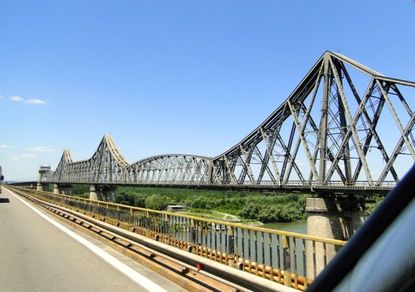
Crossing the Danube alongside a lovely sort of Forth Bridge.
The start of our journey round Romania. We left Jupiter after passing Neptune. We were soon able to add to our collection of interesting roundabouts when we arrived at the southern end of the lagoon near Constantin. There, in all its glory was a light aircraft on a stick. One of the best.
Soon after we passed over the Danube Canal where the Danube meets the Black Sea. We were not really in the Danube delta; just skirting the edges. Constantin looked a clean and tidy place even if it had lots of old communist buildings and a power station within the city.
Luckily we found a really well stocked LIDL with goodies not found in Greece or Bulgaria. Ian bought a giant tin of Goulash soup which he assures everyone makes a good base for a stew.
We followed the Danube Canal for some miles before crossing the Balta Ialomitei (an island of the delta region). Here we saw a wonderful steel bridge looking like a second hand Forth Bridge. Painting this bridge is not a non-stop event because it looks like it was never started. From here onwards the land flattened out and looked more like the Hungarian Plains. Sadly when we left the Island we had to pay 14 RON for use of the motorway we have built. Remember, we also paid to use the roads when we entered Romania as well.
The term “RON” is used to denote the Romanian currency the “Lei”.
Soon after we passed over the Danube Canal where the Danube meets the Black Sea. We were not really in the Danube delta; just skirting the edges. Constantin looked a clean and tidy place even if it had lots of old communist buildings and a power station within the city.
Luckily we found a really well stocked LIDL with goodies not found in Greece or Bulgaria. Ian bought a giant tin of Goulash soup which he assures everyone makes a good base for a stew.
We followed the Danube Canal for some miles before crossing the Balta Ialomitei (an island of the delta region). Here we saw a wonderful steel bridge looking like a second hand Forth Bridge. Painting this bridge is not a non-stop event because it looks like it was never started. From here onwards the land flattened out and looked more like the Hungarian Plains. Sadly when we left the Island we had to pay 14 RON for use of the motorway we have built. Remember, we also paid to use the roads when we entered Romania as well.
The term “RON” is used to denote the Romanian currency the “Lei”.

Yes, only 2.8 Lei for 100 gram of crap.
Near Fetesti a Danube cruise ship was moored; the same sort of ship we see in Budapest.
After some 50 km we turned off the motorway to the town with the wonderful name of Slobozia. Just about 10 Km north of Slobozia we turned into the campsite at Amara.
Amara is famous for its mud and lakes. The campsite is next to one of the lakes and they have a token bathfull of the mud. We didn’t bother.
In the evening we walked about 2 kilometers into the town and through a large park to the strand (beach area). The park was “renovated” by the EU at a cost of 3 million Euro. Not bad for a road and a car park!
We asked to look at the strand and were refused. We were not even asked to pay, just told we could not enter... so we took a photo through the fence of a lady covering herself with mud.
After dinner Ian tried to catch some crap in the lake. Yes folks this really is the word for “carp”. However his technique was crap and he never caught one.
After some 50 km we turned off the motorway to the town with the wonderful name of Slobozia. Just about 10 Km north of Slobozia we turned into the campsite at Amara.
Amara is famous for its mud and lakes. The campsite is next to one of the lakes and they have a token bathfull of the mud. We didn’t bother.
In the evening we walked about 2 kilometers into the town and through a large park to the strand (beach area). The park was “renovated” by the EU at a cost of 3 million Euro. Not bad for a road and a car park!
We asked to look at the strand and were refused. We were not even asked to pay, just told we could not enter... so we took a photo through the fence of a lady covering herself with mud.
After dinner Ian tried to catch some crap in the lake. Yes folks this really is the word for “carp”. However his technique was crap and he never caught one.
Thursday 4 July 2013
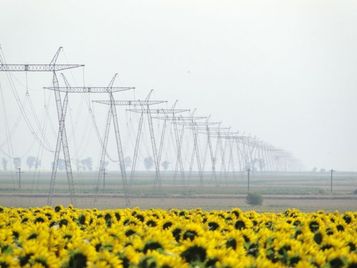
Romania can be VERY flat.
Happy Birthday Richard.
Today’s journey took us from one mud lake to another. This one is called Balta Alba. In Hungarian it could mean “white axe”... so there. Once again the countryside is really flat. At one point we could see electricity pylons marching off into infinity; it was quite amazing. Then we started to pass field after field of sunflowers. The farmers had constructed small huts in the fields from reeds and here and there we came across smallholdings out on the plain. Presumably sheep or cows were the crop. Not meaning to be rude to Romanians but they looked like Shamba in Kenya.
One of the smallholders was sitting on his donkey cart giving the poor animal a hiding with a large stick as if he wanted to break the donkey world speed record. Poor thing.
In Hungary on the plains you can see gemeskut (wells with a large lever on top for raising a bucket), but here they are every few hundred yards down the road and in the fields with the bucket swinging in the wind.
It is surprising how many vehicles are horsedrawn carts. some looked like haystacks on the road, others were full of things to sell such as ladders and rakes. Meanwhile the majority were just horses and carts.
Today’s journey took us from one mud lake to another. This one is called Balta Alba. In Hungarian it could mean “white axe”... so there. Once again the countryside is really flat. At one point we could see electricity pylons marching off into infinity; it was quite amazing. Then we started to pass field after field of sunflowers. The farmers had constructed small huts in the fields from reeds and here and there we came across smallholdings out on the plain. Presumably sheep or cows were the crop. Not meaning to be rude to Romanians but they looked like Shamba in Kenya.
One of the smallholders was sitting on his donkey cart giving the poor animal a hiding with a large stick as if he wanted to break the donkey world speed record. Poor thing.
In Hungary on the plains you can see gemeskut (wells with a large lever on top for raising a bucket), but here they are every few hundred yards down the road and in the fields with the bucket swinging in the wind.
It is surprising how many vehicles are horsedrawn carts. some looked like haystacks on the road, others were full of things to sell such as ladders and rakes. Meanwhile the majority were just horses and carts.
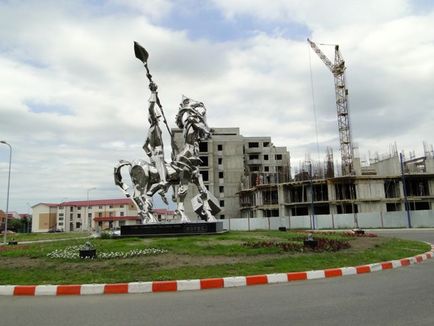
A Knight in shining stainless steel... invented by a Yorkshireman, don't forget.
Buzau was the first city we passed and in our eyes it’s claim to fame must be a beautiful statue on a roundabout (yes, another roundabout!). This was of a knight on a horse. The whole statue stood about 10 meters high and was constructed of stainless steel. It must have cost a fortune.
After taking the wrong turn and driving for several miles to find a suitable turning point we eventually arrived at Balta Alba Summer Club. What a grand name for a couple of cafes and a swimming pool next to a lake. But a family were there and the old man was caked with black mud around his shoulders. Meanwhile the children were swimming in the pool. We decided that pea-soup green was not the best colour for swimming pool water.
The majority of the lake at our end is covered in slimy algae and is not very nice to look at. But the bird life is pretty good to watch, even though we could only identify swans, cranes and moor hens.
Just like yesterday we are surrounded by dragonflies. They are amazing to watch doing their aerobatics.
After taking the wrong turn and driving for several miles to find a suitable turning point we eventually arrived at Balta Alba Summer Club. What a grand name for a couple of cafes and a swimming pool next to a lake. But a family were there and the old man was caked with black mud around his shoulders. Meanwhile the children were swimming in the pool. We decided that pea-soup green was not the best colour for swimming pool water.
The majority of the lake at our end is covered in slimy algae and is not very nice to look at. But the bird life is pretty good to watch, even though we could only identify swans, cranes and moor hens.
Just like yesterday we are surrounded by dragonflies. They are amazing to watch doing their aerobatics.
Friday 5 July 2013
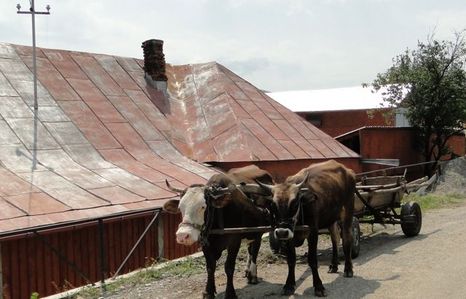
Two cow power cart in Cleja.
An easy drive between the Eastern side of the Carpathian Mountains, and the edges of Moldovia. On the way we looked at some small villages, because they are the so called Csango (pronounced Chango) villages. These people are a cut off community of Hungarians who have lived in this area for more than a 1000 years and still speak archaic Hungarian. The villages are pleasant and the main interest is the meeting of these very poor but extremely hospitable people.
On the way we saw dozens of carts pulled by one or two horses and in the Csango villages we saw carts pulled by cows.
Just north of Bacau is an amazing level crossing. It is actually a staircase with each of the two tracks higher than the other. Heaven help anyone hitting them at speed.
It is 30°C today and very humid.
On the way we saw dozens of carts pulled by one or two horses and in the Csango villages we saw carts pulled by cows.
Just north of Bacau is an amazing level crossing. It is actually a staircase with each of the two tracks higher than the other. Heaven help anyone hitting them at speed.
It is 30°C today and very humid.
Saturday 6 July 2013
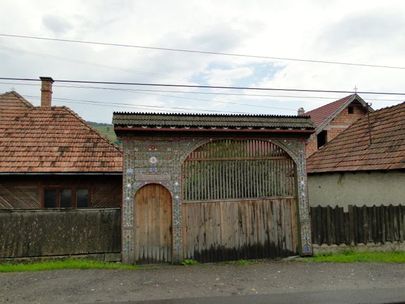
Székelykapu, typical of the Hungarian part of Romania.
Today’s journey started very well. The roads were good and the scenery very pleasant as we approached the mountains from Bacau (Bako) to Comanesti (Komarfalva). Then the road started to rise but the quality of the surface deteriorated. It was made of concrete blocks which had a) broken and b) been skimmed with a few millimeters of tarmac. Naturally this had cracked/broken/disappeared or just flaked off. That part of the journey to Ghimes (Gyimes) through the Pass was taken in 2nd and 3rd gear at about 15 to 20 mph. It took ages. At Ghimes Faget some parts of the border (called 1000 year old border) of old Hungary is still visible. The custum building, and the border marking stone. The scenery was good and the further we went it was clear we were entering the Hungarian speaking region (Szekelyfold) with garden gates peculiar to this region called Szekely Kapu. (See photos).
After Faget the road was much better and we climbed to about 3500 ft to cross over the Csiki Havasok mountain range. At the summit some locals tried to sell us a bucket of afonya (similar to cranberries). Down the other side we could see a broad plain and the town of Mercurea Ciuc (Csikszereda) and the adjacent town of Csiksomlyo.
After Faget the road was much better and we climbed to about 3500 ft to cross over the Csiki Havasok mountain range. At the summit some locals tried to sell us a bucket of afonya (similar to cranberries). Down the other side we could see a broad plain and the town of Mercurea Ciuc (Csikszereda) and the adjacent town of Csiksomlyo.
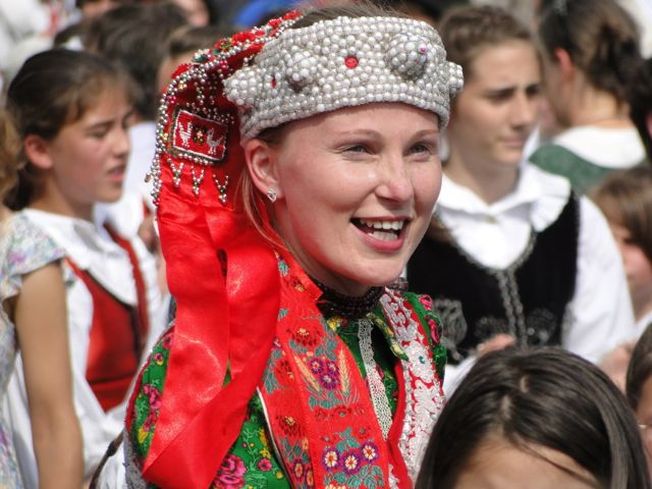
Just one of the beautiful costumes at the Folk Dance Festival.
The plan was to visit Csiksomlyo (next to Miercurea Ciuc) because there is a once a year folk dancing festival called “1000 Beautiful Szekely Girls”. And there was. But the actual event was up a very steep hill. How they could dance after that, shows how young and fit they are.
Csiksomlyo firstly is the most important pilgrimage place in Transylvania. Every year houndreds of thousands Szekely and Csango catholics gather here at Whitsuntide. It is also the headquarters of the Transylvanian Franciscan order.
With 1000 beautiful girls and probably another 2000 spectators we were surprised to see only two portaloos! The dancing was good and we partook of Kurtoskalacs (dough wrapped around a wooden roller and baked over charcoal) and langos (dough deep fried with lashings of cheese and other goodies. The costumes were lovely. We were lucky to leave when we did because of a sudden thunderstorm.
Our next job was to find a place to stay. Our old Hungarian guidebook told us of a rough campsite and a Panzio (pension) we found the Panzio but they were closed. Luckily a filling station man directed us to an old bathing site where there is a car park. The campsite is abandoned but there is a place to savour the sour water coming from underground through four taps. While we were there several families turned up for a drink and/or a picnic. People filled up several plastic bottles to take with them.
Csiksomlyo firstly is the most important pilgrimage place in Transylvania. Every year houndreds of thousands Szekely and Csango catholics gather here at Whitsuntide. It is also the headquarters of the Transylvanian Franciscan order.
With 1000 beautiful girls and probably another 2000 spectators we were surprised to see only two portaloos! The dancing was good and we partook of Kurtoskalacs (dough wrapped around a wooden roller and baked over charcoal) and langos (dough deep fried with lashings of cheese and other goodies. The costumes were lovely. We were lucky to leave when we did because of a sudden thunderstorm.
Our next job was to find a place to stay. Our old Hungarian guidebook told us of a rough campsite and a Panzio (pension) we found the Panzio but they were closed. Luckily a filling station man directed us to an old bathing site where there is a car park. The campsite is abandoned but there is a place to savour the sour water coming from underground through four taps. While we were there several families turned up for a drink and/or a picnic. People filled up several plastic bottles to take with them.
Sunday 7 July 2013
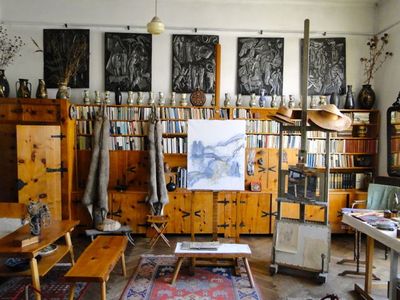
Studio of Nagy Imre.
Our first task in the morning was to fill up the toilet flushing tank with the sour water before visiting the Nagy Imre museum in Zsögöd (part of Csikszereda). Nagy Imre was a famous Szekely artist. Judit spent some time in there while Ian chatted with the husband of the museum lady. The whole family were curious about the motorhome and we had a good time with them.
From there it was a short ride, but complicated by new one-way streets to the castle in Csikszereda. It is now a museum. The majority of items on display were “pecsets”. We would call them a seal or stamp ... like a rubber stamp. A very interesting part of the museum was taken up with displays of artefacts, and stories, from his expedition to Indonesia in the late 1800s. You must pay extra to take photos!
After the museum our route took us over the Harghita mountains towards Odorheiu Secuiesc (Székelyudvarhely in Hungarian). The road serface was excellent, but the twisting roads were made challenging as we were in the middle of a massive thunderstorm. One of the dashboard warning lights started flashing but thankfully stopped flashing when the rain stopped. No idea why.
Baile Homorod was a good place to stop and have an excellent lunch in a small restaurant. For such a small place the food was well prepared and beautifully presented. The chef must be very talented. Ian had pig knuckle with beans and saouted potatoes, while Judit had a cheese filled schnitzel and chips. It sounds very simple but it was good.
From there it was a short ride, but complicated by new one-way streets to the castle in Csikszereda. It is now a museum. The majority of items on display were “pecsets”. We would call them a seal or stamp ... like a rubber stamp. A very interesting part of the museum was taken up with displays of artefacts, and stories, from his expedition to Indonesia in the late 1800s. You must pay extra to take photos!
After the museum our route took us over the Harghita mountains towards Odorheiu Secuiesc (Székelyudvarhely in Hungarian). The road serface was excellent, but the twisting roads were made challenging as we were in the middle of a massive thunderstorm. One of the dashboard warning lights started flashing but thankfully stopped flashing when the rain stopped. No idea why.
Baile Homorod was a good place to stop and have an excellent lunch in a small restaurant. For such a small place the food was well prepared and beautifully presented. The chef must be very talented. Ian had pig knuckle with beans and saouted potatoes, while Judit had a cheese filled schnitzel and chips. It sounds very simple but it was good.
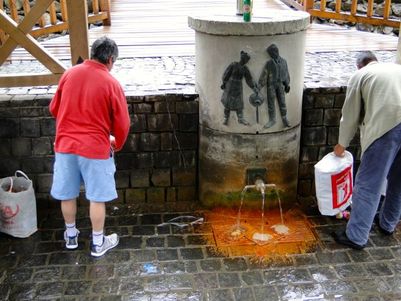
Iron-rich water... good for everything.
Outside was another source of “healing water”. It was amazing to see cars stopping at the roadside, drivers nipping out and taking sacks of empty bottles to fill up with the water. They must be very healthy or very sick.
After the break we passed a giant meadow which had more than a hundred horses roaming around. Quite a sight.
We’d heard of a good campsite in Székelyudvarhely but we could not find it so we took a road north to Zetalaka. Many years ago we camped up there with the Hungarian Land Rover Club. The road did not offer any night stop possibilities but we saw a pension sign and a large yard so asked if we could stay there. The owners, Lajos and Jolan were very hospitable and we were soon enjoying a beer and a palinka... and chocolate cake. Lajos runs a woodyard and is a very talented carpenter. The house and every other building were made by him, the furniture and just about everything else were made by him. The place is really outstanding.
For the pet lovers, he owns a guard dog called Juhasz (shepherd). It’s a giant Argentinian dog. It’s a bit sneaky though because after giving him a good stroke he’s likely to nip at your backside when you walk away.
After the break we passed a giant meadow which had more than a hundred horses roaming around. Quite a sight.
We’d heard of a good campsite in Székelyudvarhely but we could not find it so we took a road north to Zetalaka. Many years ago we camped up there with the Hungarian Land Rover Club. The road did not offer any night stop possibilities but we saw a pension sign and a large yard so asked if we could stay there. The owners, Lajos and Jolan were very hospitable and we were soon enjoying a beer and a palinka... and chocolate cake. Lajos runs a woodyard and is a very talented carpenter. The house and every other building were made by him, the furniture and just about everything else were made by him. The place is really outstanding.
For the pet lovers, he owns a guard dog called Juhasz (shepherd). It’s a giant Argentinian dog. It’s a bit sneaky though because after giving him a good stroke he’s likely to nip at your backside when you walk away.
Tuesday 9 July 2013
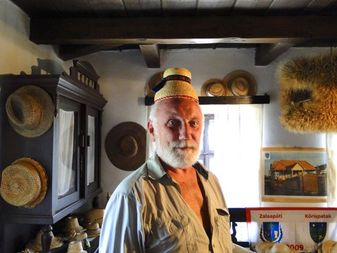
Ian tries out a traditional straw hat.
On our way to the Straw Hat Museum at Körispatak we passed some lovely countryside. This part of Romania is a delight; just beware that the road surface may disappear at any time. It did when we took a detour to Inlaceni (Énlaka) and had to reverse for about one kilometer. It is said that Énlaka is beautiful and wishes to be a World Heritage Site. If the judges can get there it may do so.
Once in Körispatak we went immediately to the Straw Hat Museum. It is really rather good and explains about the straw hat traditions in the area. They are twinned with another Straw Hat Museum in Oxford.
The people of the village are very kind and everyone greets everyone else on the street, including tourists like us. We ate at the only restaurant with a party of Hungarians from Miskolc. The food was delicious. We started with a cabbage and meat soup, followed by Green Pea Főzelék with chicken. We finished the meal with pancakes. Of course we were greeted with a glass of palinka and some local red wine.
Főzelék is a special category in Hungarian cuisine, not quite a soup, but neither is it a stew .It is simply cooked, typically by simmering, not mashed and is delicious.
After dinner we all went on a ride around the village on a horse cart and later walked to the top of a surrounding hill to see the village.
We heard of one lady on a local sheep farm who milks 300 sheep every morning and evening, then goes to work at the local bakery. Don’t believe everything in the newspapers. Most Romanians work very hard.
Once in Körispatak we went immediately to the Straw Hat Museum. It is really rather good and explains about the straw hat traditions in the area. They are twinned with another Straw Hat Museum in Oxford.
The people of the village are very kind and everyone greets everyone else on the street, including tourists like us. We ate at the only restaurant with a party of Hungarians from Miskolc. The food was delicious. We started with a cabbage and meat soup, followed by Green Pea Főzelék with chicken. We finished the meal with pancakes. Of course we were greeted with a glass of palinka and some local red wine.
Főzelék is a special category in Hungarian cuisine, not quite a soup, but neither is it a stew .It is simply cooked, typically by simmering, not mashed and is delicious.
After dinner we all went on a ride around the village on a horse cart and later walked to the top of a surrounding hill to see the village.
We heard of one lady on a local sheep farm who milks 300 sheep every morning and evening, then goes to work at the local bakery. Don’t believe everything in the newspapers. Most Romanians work very hard.
Wednesday 10 July 2012
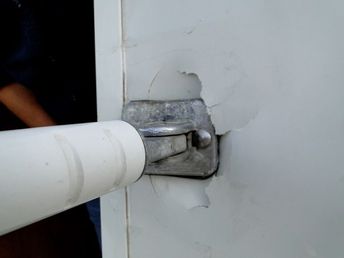
The garden gate jumped sideways... honest.
It really should be another Friday 13th. On leaving the garden one of the gate posts jumped an inch and damaged the side of Bessy. It’s a small hole but needs mending ASAP.
Because of the lack of roads around the Straw Hat Museum village we had to retrace our steps for some distance, but it is a pleasant drive. There is one village on the way that has two churches and they are both leaning towards the other. We also passed some charcoal burners and plenty of people working in the fields. One view reminded Ian of when he was a child in Yorkshire helping with the haymaking, with horses and carts and lots of people.
Once we hit the main road we turned to pass through Corund (Korond) which is famous for pottery. Lots of goodies on sale at the roadside.
Once past Korond you go through Praid (Paraid) which has a salt mine. We’ve been before, but it really is worth stopping to visit the mine. You take a long bus ride into the mine and you can then walk around in massive chambers and see how the salt is extracted. People visit here to sit in the mine because it is said to cure respiratory diseases.
It’s only a few kilometers from there to Sovate where there are several lakes and a famous one called Medve Tó (Bear Lake) where you can swim in the salty water and sunbathe. There are also several campsites of varying standard. Probably the best is Vasskert Camping (see Night Stop notes). We got ourselves nicely established before a massive thunderstorm cracked overhead.
Because of the lack of roads around the Straw Hat Museum village we had to retrace our steps for some distance, but it is a pleasant drive. There is one village on the way that has two churches and they are both leaning towards the other. We also passed some charcoal burners and plenty of people working in the fields. One view reminded Ian of when he was a child in Yorkshire helping with the haymaking, with horses and carts and lots of people.
Once we hit the main road we turned to pass through Corund (Korond) which is famous for pottery. Lots of goodies on sale at the roadside.
Once past Korond you go through Praid (Paraid) which has a salt mine. We’ve been before, but it really is worth stopping to visit the mine. You take a long bus ride into the mine and you can then walk around in massive chambers and see how the salt is extracted. People visit here to sit in the mine because it is said to cure respiratory diseases.
It’s only a few kilometers from there to Sovate where there are several lakes and a famous one called Medve Tó (Bear Lake) where you can swim in the salty water and sunbathe. There are also several campsites of varying standard. Probably the best is Vasskert Camping (see Night Stop notes). We got ourselves nicely established before a massive thunderstorm cracked overhead.
Thursday 11July 2013
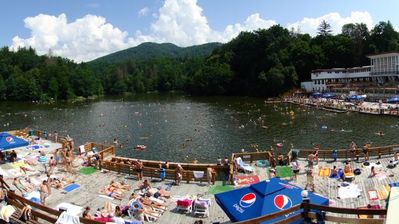
Medve Tó (Bear Lake) Sovata.
The walk to Bear Lake was a surprise. It’s almost all uphill and the temperature and humidity did not make the walk any easier. It’s only 2 km but felt longer.
We were unable to get a concessionary ticket even for Hungarians! But the Lake is well kept and surrounded by forest and hills on two sides with the bathing and dressing rooms area on the other sides. It’s busy so go early. It is full of people of all shapes and sizes. Some quite amazing!
At 1300 everybody has to get out of the lake. I quote, “In order to protect the heliothermal effect of the Lake it is PROHIBITED: to have a bath between 13.00-15.00 o’clock, to jump into the water, to play with the ball, to use the mud and to pass the buoys.” So there!
I also note that in the surrounding forest you are not allowed to use mud - except in authorized places.
We think that you have to leave the water so that everyone goes for lunch at the surrounding cafes. Anyway we left and walked downhill to the town. On the way we stopped at a butchers and asked for minced beef, but they didn’t have a mincer. We bought sturdy sausages instead and tonight we are having Parikás Krumpli.
Should we include some of our recipes? Some people have special motorhome recipes but we eat whatever we want. If there is a demand we’ll include some of our favourites.
Ian keeps forgetting to mention the gas pipes. Yes, the gas pipes. Just like in Hungary the gas pipes from the road to the house must be visible. But here they can also be seen at the roadside. They look very vulnerable to bad driving.
We were unable to get a concessionary ticket even for Hungarians! But the Lake is well kept and surrounded by forest and hills on two sides with the bathing and dressing rooms area on the other sides. It’s busy so go early. It is full of people of all shapes and sizes. Some quite amazing!
At 1300 everybody has to get out of the lake. I quote, “In order to protect the heliothermal effect of the Lake it is PROHIBITED: to have a bath between 13.00-15.00 o’clock, to jump into the water, to play with the ball, to use the mud and to pass the buoys.” So there!
I also note that in the surrounding forest you are not allowed to use mud - except in authorized places.
We think that you have to leave the water so that everyone goes for lunch at the surrounding cafes. Anyway we left and walked downhill to the town. On the way we stopped at a butchers and asked for minced beef, but they didn’t have a mincer. We bought sturdy sausages instead and tonight we are having Parikás Krumpli.
Should we include some of our recipes? Some people have special motorhome recipes but we eat whatever we want. If there is a demand we’ll include some of our favourites.
Ian keeps forgetting to mention the gas pipes. Yes, the gas pipes. Just like in Hungary the gas pipes from the road to the house must be visible. But here they can also be seen at the roadside. They look very vulnerable to bad driving.
Friday 12 July 2013
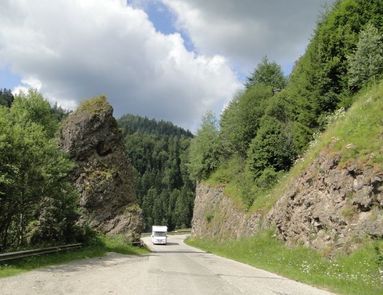
Road near Colibitsa Dam.
We spent an hour giving Bessy a good cleaning and headed south from Sovata through Targa Mures. Later Ian disappointed Judit by refusing to drive on a really rough road to see a lake with a dam with a submerged village. Now heading north we stopped in the village of Glodeni to look at a country house owned by the famous Hungarian Teleki family. Sadly our road map put the wrong museum in the wrong place. Luckily a few kilometers north on the main road we stopped right outside the correct place. We spotted a man through the locked gates and he allowed us in to roam around the Castely (country house/palace). It is a lovely place but needs a lot of work doing on it. A Belgian Scout group were helping with the renovation.
Our map showed a campsite at Bistrita but they only had a LIDL. The map is so out of date it is a hazard.
About 30 Km north of Bistrita is a nature reserve in the mountainous forest, complete with large dam. We stopped at a shelter to ask for advice and luckily met Iaon, the Head Ranger, who spoke perfect English. He advised us to camp in the nearby picnic area. He even wrote out a note for us to show if we had an people objecting.
The picnic area is approached up a rough dirt road and was very peaceful... until the local nurd with a dunga-dunga car arrived to shatter the silence.
Our map showed a campsite at Bistrita but they only had a LIDL. The map is so out of date it is a hazard.
About 30 Km north of Bistrita is a nature reserve in the mountainous forest, complete with large dam. We stopped at a shelter to ask for advice and luckily met Iaon, the Head Ranger, who spoke perfect English. He advised us to camp in the nearby picnic area. He even wrote out a note for us to show if we had an people objecting.
The picnic area is approached up a rough dirt road and was very peaceful... until the local nurd with a dunga-dunga car arrived to shatter the silence.
Saturday 13 July 2013
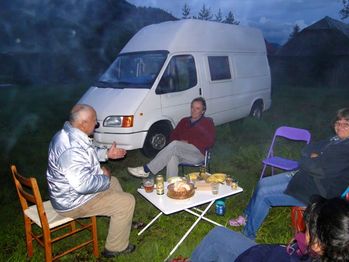
Vladimir, Lex and Judit.
Eventually the din subsided and we had a very peaceful night. We continued northward past Piatra Fantanele where there is a hotel in an old castle, reputed to be where Dracula stopped on one of his journeys. To be honest it was so spectacular that we nearly missed it!
Further north is the Dutch campsite Camping de Fuurplaats but we could not see any signs of it so we continued our journey. The road is really good and we slowly wound our way downhill to Vatra Dornei where we took the chance to raid the hole in the wall for a bit more cash.
Then we took the decision to take the road to the Prislop Pass. The first 20 km were a nightmare of potholes and we stopped in the small village of Ciacanesti to get our bearings. At the other side of the road was a campsite. It looked a bit overgrown but we walked up the drive to check it out and were met by Vladimir who showed us around. His campsite is rustic but perfect in almost every way. He has all the facilities including a dump, electric, water and excellent wifi. Later a Dutch couple, Lex and Ruth arrived and we spent a very pleasant, if cool, evening chatting with them and Vladimir. We used our fresh food from the ailing fridge but Vladimir cooked our new friends an excellent meal. A very nice place indeed.
Further north is the Dutch campsite Camping de Fuurplaats but we could not see any signs of it so we continued our journey. The road is really good and we slowly wound our way downhill to Vatra Dornei where we took the chance to raid the hole in the wall for a bit more cash.
Then we took the decision to take the road to the Prislop Pass. The first 20 km were a nightmare of potholes and we stopped in the small village of Ciacanesti to get our bearings. At the other side of the road was a campsite. It looked a bit overgrown but we walked up the drive to check it out and were met by Vladimir who showed us around. His campsite is rustic but perfect in almost every way. He has all the facilities including a dump, electric, water and excellent wifi. Later a Dutch couple, Lex and Ruth arrived and we spent a very pleasant, if cool, evening chatting with them and Vladimir. We used our fresh food from the ailing fridge but Vladimir cooked our new friends an excellent meal. A very nice place indeed.
Sunday 14 July 2013
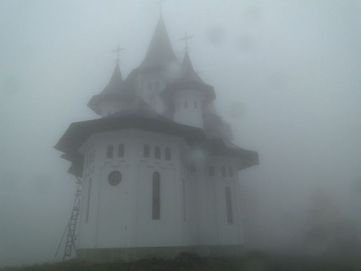
Monastery on Prislip Pass. We nearly missed it!
We said our goodbyes to Ruth, Lex and Vladimir and continued up the awful road. It took us 4 hours to cover 60 Km, never getting higher than second gear. But eventually we got to the summit of Prislop Pass... in the cloud and drizzle. There is a simple restaurant there and we decided to lunch there. We ate a very good vegetable soup complete with a raw hot chili each. Ian ate the Mititei. The story has it a popular mid-19th-century Romanian inn, famous for its sausages, was out of a customer favorite. To save time, the chef formed the unstuffed meat mixture into sausage-shaped cylinders and grilled them over charcoal. The customers delighted in "the wee ones without skin," and so these casing-less sausages became known as mititei or "the wee ones." Judit’s choice was less spectacular as she thought she was getting schnitzel with cheese. It turned out to be slabs of fried cheese.
Down through the mist on the rough road through Borsa Tourist Centre, where people ski in winter, and then through Borsa itself. It is a really long ribbon development and not very attractive. When we arrived at Viseu de Sus we saw the first signs of roadworks. The idiots had resurfaced the road to a depth of about 30 cm, but left the manholes and drains at the original depth. Every vehicle was doing a slalom through the small town. It was time to stop and we found one of Ian Manzie’s stops at the station of the Carpathian Forest Steam Railway. Just a car park, but they have clean toilets and a very good wifi from the cafe.
Down through the mist on the rough road through Borsa Tourist Centre, where people ski in winter, and then through Borsa itself. It is a really long ribbon development and not very attractive. When we arrived at Viseu de Sus we saw the first signs of roadworks. The idiots had resurfaced the road to a depth of about 30 cm, but left the manholes and drains at the original depth. Every vehicle was doing a slalom through the small town. It was time to stop and we found one of Ian Manzie’s stops at the station of the Carpathian Forest Steam Railway. Just a car park, but they have clean toilets and a very good wifi from the cafe.
Monday 15 July 2013
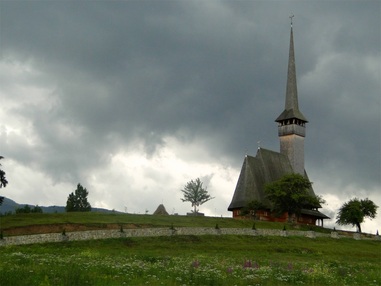
Iued Wooden Church.
We decided not to take the train in the morning because the weather was still cloudy and drizzling. Instead we stood and watched a lovely old steam engine make clouds of smoke and steam. Very nice indeed.
The decision had been made to visit some wooden churches in the area, so once again we headed north and then turned off for Bocicoel and Bogdan Voda. The churches look very attractive because they are completely made of wood and the steep shingle roofs look really good.
Our next target was Dragominesti, but we were side tracked by a fabulous market in a field at the entrance to the village. There you could buy anything from a bead bracelet to a cow, straw hat to a cow bell. The atmosphere was excellent. Gypsie ladies in very colourful clothing and old ladies in pleated mini skirts completed the picture.
Our next target was Ieud (In Hungarian Jód, which means iodine). This was a lovely church in a fabulous setting. They overcast sky made the photograph a must. This church is the oldest in the area dating from 1362. Another plus point was the excellent asphalt road up to the church.
On again, this time to Botiza but in pouring rain. We had to stop because of the reduced visibility. This time the road was bad but the church was interesting because it was being renovated. It was built in 1699 but moved to its present location in 1899.
Yet another church. This time the tallest wooden spire in Europe at Barsana... 62 meters. In the evening we walked through the village and Judit bought a large traditional shopping bag... more like a sack!
Ladies are still wearing black pleated mini skirts.
We stopped the night in the overflow carpark and had a very peaceful sleep, despite the cold.
The decision had been made to visit some wooden churches in the area, so once again we headed north and then turned off for Bocicoel and Bogdan Voda. The churches look very attractive because they are completely made of wood and the steep shingle roofs look really good.
Our next target was Dragominesti, but we were side tracked by a fabulous market in a field at the entrance to the village. There you could buy anything from a bead bracelet to a cow, straw hat to a cow bell. The atmosphere was excellent. Gypsie ladies in very colourful clothing and old ladies in pleated mini skirts completed the picture.
Our next target was Ieud (In Hungarian Jód, which means iodine). This was a lovely church in a fabulous setting. They overcast sky made the photograph a must. This church is the oldest in the area dating from 1362. Another plus point was the excellent asphalt road up to the church.
On again, this time to Botiza but in pouring rain. We had to stop because of the reduced visibility. This time the road was bad but the church was interesting because it was being renovated. It was built in 1699 but moved to its present location in 1899.
Yet another church. This time the tallest wooden spire in Europe at Barsana... 62 meters. In the evening we walked through the village and Judit bought a large traditional shopping bag... more like a sack!
Ladies are still wearing black pleated mini skirts.
We stopped the night in the overflow carpark and had a very peaceful sleep, despite the cold.
Tuesday 16 July 2013
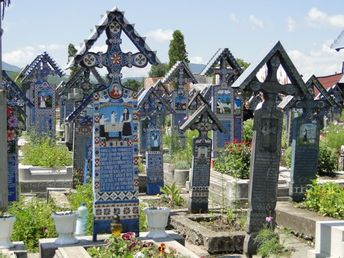
The Merry Cemetery at Sapanta.
The weather improved today and on our way to the filling station to buy a vignette we saw many houses which were tiled on the outside. Fascinating patterns.
While buying the vignette to drive on the roads we have built we pondered on the fact that we have seen dozens of UK registered vehicles from Transits to Minis but none of them have a tax disc. In this area we saw many French registered cars.
When we arrived at Sighetu Marmatiei (Mármarossziget) we took a side road to the Skansen (open air museum). The wooden houses were up to several hundred years old and many of them were built with massive “planks” 6 inch thick and around 2 feet wide. Quick to build if you have a lot of mates.
In the city we took advantage of a LIDL to stock up on milk before driving through nice countryside to Sapanta (Szaplonca). Here is the famous Cheerful Cemetery. And it really is. Every grave has a wooden “headstone” with a painting of the resident and a poem about their live. Sadly the entrance fee did not entitle us to a translation of the poems. As a lot of the people spoke English it would have been something to buy. Instead the shopping opportunities are across the road where old ladies sell “traditional goods”.
It was now mid afternoon and we went to look for a campsite that our Dutch friends Lex and Ruth had told us about. The Dutch seem to have more access to information about Eastern European campsites than the Brits.
Sure enough it was almost exactly where the coordinates sent us. The campsite is quite small and next to a Pension. We had the choice of the plot, but in the evening the place filled up with three tents, three Land Rovers, three more motorhomes and a French caravan.
While buying the vignette to drive on the roads we have built we pondered on the fact that we have seen dozens of UK registered vehicles from Transits to Minis but none of them have a tax disc. In this area we saw many French registered cars.
When we arrived at Sighetu Marmatiei (Mármarossziget) we took a side road to the Skansen (open air museum). The wooden houses were up to several hundred years old and many of them were built with massive “planks” 6 inch thick and around 2 feet wide. Quick to build if you have a lot of mates.
In the city we took advantage of a LIDL to stock up on milk before driving through nice countryside to Sapanta (Szaplonca). Here is the famous Cheerful Cemetery. And it really is. Every grave has a wooden “headstone” with a painting of the resident and a poem about their live. Sadly the entrance fee did not entitle us to a translation of the poems. As a lot of the people spoke English it would have been something to buy. Instead the shopping opportunities are across the road where old ladies sell “traditional goods”.
It was now mid afternoon and we went to look for a campsite that our Dutch friends Lex and Ruth had told us about. The Dutch seem to have more access to information about Eastern European campsites than the Brits.
Sure enough it was almost exactly where the coordinates sent us. The campsite is quite small and next to a Pension. We had the choice of the plot, but in the evening the place filled up with three tents, three Land Rovers, three more motorhomes and a French caravan.
Wednesday 17 July 2013
The weather has become a bit more sunny. The last few days has ben cloudy and stormy. So with the nice weather we took a walk up the road out of the village. The idea was to cross the river but the only bridge was a single log with a flattened top. As it was a good 10 foot drop into the rocky river we decided not to bother. The rest of the day was spent in making notes and generally lounging around.
Thursday 18 July 2013
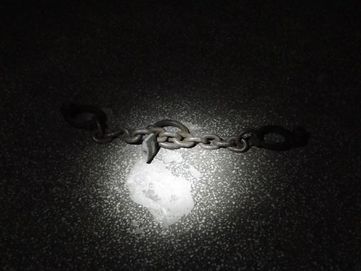
The Black Cell in the Communist Prison.
Time to leave Sapanta. As we drove through the village many of the ladies were dressed in their folk costumes. No idea why. Our route took us back along the same road for a while until we finally arrived at Mármarossziget (Sighetu Marmatiei, or Marmite to you and me). It’s quite a pleasant town and we spent some time walking around. The local hotel was offering lunch of pork and chips for 7 RON (about £1.36) but it was too early so we visited the Museum in a Communist Prison. It was surprising to note that around 600,000 people were locked up by the Communists as being dangerous to the system; people such as priests, writers, lawyers and professors. In fact just about anyone they thought was subversive. Possibly the worst cell was the Black Cell or Punishment Cell. Completely dark with just some shackles fixed to the floor!
We were still passing wooden churches, some of them very elaborate indeed.
We left the town and stopped to make our lunch in a rough car park opposite a trout farm/restaurant, complete with waterfall. Many of the trout were leaping out of the water.
Onward and upward with the intention of stopping for the night on Gutin Pass summit (1447 Meters, 4747 Feet). After trying to have an afternoon snooze we abandoned the idea and left, but not before being “attacked” by a very friendly butterfly. It just would not go away and was continually sitting on our hands and heads for a good ten minutes.
Anyway, we headed for Baia Mara (Nagy Banya in Hungarian. Big Mine in English) There was a road north out of town towards the hills and a lake so we thought there might be a decent Night Stop. After a few miles we found an hotel with camping signs but they didn’t have space anymore because they had made their camp into a trout farm. The young man who spoke English said it was OK in the car park opposite, so we did and had a peaceful night.
We enquired about the trout and were told that the biggest were the females at 7 kilo each!
We were still passing wooden churches, some of them very elaborate indeed.
We left the town and stopped to make our lunch in a rough car park opposite a trout farm/restaurant, complete with waterfall. Many of the trout were leaping out of the water.
Onward and upward with the intention of stopping for the night on Gutin Pass summit (1447 Meters, 4747 Feet). After trying to have an afternoon snooze we abandoned the idea and left, but not before being “attacked” by a very friendly butterfly. It just would not go away and was continually sitting on our hands and heads for a good ten minutes.
Anyway, we headed for Baia Mara (Nagy Banya in Hungarian. Big Mine in English) There was a road north out of town towards the hills and a lake so we thought there might be a decent Night Stop. After a few miles we found an hotel with camping signs but they didn’t have space anymore because they had made their camp into a trout farm. The young man who spoke English said it was OK in the car park opposite, so we did and had a peaceful night.
We enquired about the trout and were told that the biggest were the females at 7 kilo each!
Friday 19 July 2013
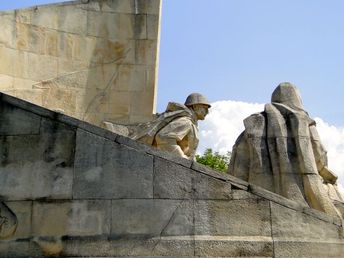
Nagy Banya War Memorial.
On the road back into Nagy Banya we stopped to photograph the lake and also dustbins surrounded by a wire cage to stop the bears. Judit’s objective was the town Art Museum.
It turned out to be very good with some lovely paintings. Also some very strange ones which would never get onto anyone’s wall.
After the art gallery we had a walk round the nearby town centre and treated ourselves to a cappuccino and an ice cream. For a mining town it’s very pleasant indeed.
Our road towards Kolozsvár (Clui Napoca) turned out to be the best road in Romania. But we have driven on roads funded by the EU that should have been finished in 2013 but have never been started.
We turned off at Rastoci to cut the corner to Huedin. The scenery was very pleasant and we passed through many small villages and over many newly built bridges. We had to wait at one level crossing for quite a while when a very long freight train passed. Of course one car took advantage of the lack of gates and jumped the queue. Lucky for the train he got through OK.
From Zimbor the road quality deteriorated. It was originally concrete blocks but had been skimmed with tarmac. We felt every crack for about 25 Km. Hopefully Bessy is not suffering too much from all the banging and crashing.
At Huedin we turned right onto the very, very busy No 1 road towards Oradea. After about 25 Km we turned off to the left to a NS someone gave us. However we didn’t find it. Instead we found an old campsite with yellow wooden huts in a big field by the river. Just a couple of caravans and ourselves made for a peaceful night.
It turned out to be very good with some lovely paintings. Also some very strange ones which would never get onto anyone’s wall.
After the art gallery we had a walk round the nearby town centre and treated ourselves to a cappuccino and an ice cream. For a mining town it’s very pleasant indeed.
Our road towards Kolozsvár (Clui Napoca) turned out to be the best road in Romania. But we have driven on roads funded by the EU that should have been finished in 2013 but have never been started.
We turned off at Rastoci to cut the corner to Huedin. The scenery was very pleasant and we passed through many small villages and over many newly built bridges. We had to wait at one level crossing for quite a while when a very long freight train passed. Of course one car took advantage of the lack of gates and jumped the queue. Lucky for the train he got through OK.
From Zimbor the road quality deteriorated. It was originally concrete blocks but had been skimmed with tarmac. We felt every crack for about 25 Km. Hopefully Bessy is not suffering too much from all the banging and crashing.
At Huedin we turned right onto the very, very busy No 1 road towards Oradea. After about 25 Km we turned off to the left to a NS someone gave us. However we didn’t find it. Instead we found an old campsite with yellow wooden huts in a big field by the river. Just a couple of caravans and ourselves made for a peaceful night.
Saturday 20 July 2013
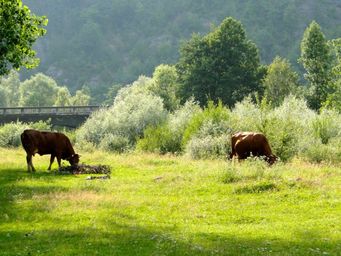
The peaceful campsite at Bucea.
We decided to stay another night and enjoy the beautiful surroundings. In the morning we took a walk into the nearest village of Bucea where we found the least shop looking shop we’ve ever seen. It looked completely deserted except for five drunks sitting in the doorway sorting out the world’s problems. (Note: 11-00 am)
We wanted eggs, milk and fruit. We came away with 2 cans of beer, a pot of yoghurt and a litre of milk which turned out to be sour already.
When we returned to the camp it was filling up with weekenders from local cities. We chatted for a while with a Hungarian speaking grandfather and his grandson who spoke English. The grandson, Patrick, helped Ian to speak to the camp lady in Romanian. She allowed him to charge his laptop in one of the yellow huts. He also paid her 10 RON for the night (£1.95). Take note, UK campsites that charge £30 a night!
We wanted eggs, milk and fruit. We came away with 2 cans of beer, a pot of yoghurt and a litre of milk which turned out to be sour already.
When we returned to the camp it was filling up with weekenders from local cities. We chatted for a while with a Hungarian speaking grandfather and his grandson who spoke English. The grandson, Patrick, helped Ian to speak to the camp lady in Romanian. She allowed him to charge his laptop in one of the yellow huts. He also paid her 10 RON for the night (£1.95). Take note, UK campsites that charge £30 a night!
Sunday 21 July 2013
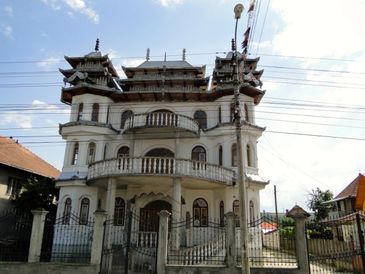
Quite a lot of flashy houses near Huedin.
Today is hot and sticky but we plan to drive all the way to Balaton in Hungary. First stop was at Carrefour on the outskirts of Oradea. Then we followed the border south until Salonta when we turned off to the Hungarian border post. This crossing is much quieter than many of the others. In fact we found the Romanians and Hungarians sharing the same checkpoint.
As we were passing Szarvas it was time for lunch. It was here we found a nice peaceful road and car park outside the arboretum. If anyone’s interested it would make a good Night Stop. (N 46° 52.464', E 20° 31.674')
But we plodded on to Balaton Almadi where we will be stopping for a time to see the Hungarian half of the family. We also hope to sort out some minor repairs in Budapest.
As we were passing Szarvas it was time for lunch. It was here we found a nice peaceful road and car park outside the arboretum. If anyone’s interested it would make a good Night Stop. (N 46° 52.464', E 20° 31.674')
But we plodded on to Balaton Almadi where we will be stopping for a time to see the Hungarian half of the family. We also hope to sort out some minor repairs in Budapest.
Where is the money going!
We pay the EU a great deal of money every day.
In turn the EU hands it over to countries like Romania and Bulgaria... and then the money seems to disappear.
We have seen many road building projects that should have been completed in August 2013 that haven't even been started. We have also seen contracts for road building given to countries such as Israel which are not in the EU.
Maybe the money goes to the Church!
Recipient of an IMF bailout in 2009 and one of the poorest countries in the EU, Romania gives millions of Euros to the Orthodox Church every year.
From central government funds the church receives more than 100 million euros for priests' salaries, and many more millions for the construction and renovation of church buildings.
In Romania the Church is building 3 new churches a week with State money!
The obvious question is, "Why is the EU not controlling what happens to our money?"
In turn the EU hands it over to countries like Romania and Bulgaria... and then the money seems to disappear.
We have seen many road building projects that should have been completed in August 2013 that haven't even been started. We have also seen contracts for road building given to countries such as Israel which are not in the EU.
Maybe the money goes to the Church!
Recipient of an IMF bailout in 2009 and one of the poorest countries in the EU, Romania gives millions of Euros to the Orthodox Church every year.
From central government funds the church receives more than 100 million euros for priests' salaries, and many more millions for the construction and renovation of church buildings.
In Romania the Church is building 3 new churches a week with State money!
The obvious question is, "Why is the EU not controlling what happens to our money?"
